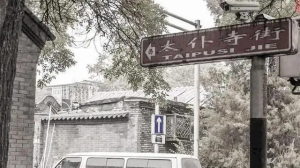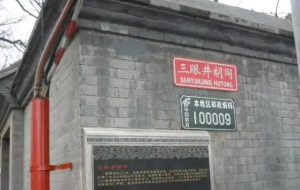Hutong street and its characteristics in Beijing
Hutong is like the vein of ancient capital, each has its own name, or loud, or containing rhyme, or simple. The hutong, shaded by locust trees and with grey walls, is surrounded by elegant Hutong names, highlighting the classical beauty of the ancient capital, which is elegant, dignified and quiet.
The word “hutong” originated from the Yuan Dynasty “Xijin Zhi”, which stipulated that the width of six steps is a hutong, 12 steps is a street, and 24 steps is a street.
After changes, by the Qing Dynasty, the number of hutongs had increased to more than 2,000, and by 1949 there were more than 3,200.
The above picture shows a detailed map of Beijing city, showing the layout and context of the city.
In the map of Beijing, hutong names are colorful. The depth of flowers in Xicheng District, the name is like its scenery, the flowers are numerous and the leaves are luxuriant, and the winding path is deep and quiet.
Douban Hutong and Sanyanjing Hutong are full of city atmosphere. Hutong names not only carry residents’ memories.
But also are closely connected with occupations, commodities and even small animals.
Hutong names not only mark the location, but also highlight the Beijing people’s straight, quick, pragmatic character. Popular names that are easy to remember and have significant references are the most popular, and practical names come first.

In the ancient alleys of Beijing, there is a hidden alley named Sanyanjing, which is full of historical charm and traces of time.
Beijing Hutong names are rich and varied, all from life, rich in folk charm, reflecting the wisdom and perspective of ordinary people, showing a unique cultural charm.
The Hutong name comes from the residents, bringing together heroes, princes, and ordinary people traders, showing all the human beings.
Zhang Zizhong, a hero of Linqing, Shandong Province, born in 1890, once sent his troops to Taierzhuang and killed thousands of enemies.
In May 1940, he died bravely in the Battle of Xiangfan, which will go down in history forever.
In order to commemorate the anti-Japanese hero Zhang Zizhong, the Iron Lion Alley in the east of the South Street Road of Dongcheng Jiaokou has now been renamed Zhang Zizhong Road.
In the ancient and solemn Zhang Zizhong road, the traces of history flow quietly, telling the heroic years.
Many hutong named after people’s titles and official positions, such as Wuding Hou, Yongkang Hou, Suian Bo, Guangning Bo, etc.,
Are derived from the former duke and earl’s residence, using their titles and official names into lane names.
In the hutongs of Beijing, the hutongs named after their surnames, such as Shi Jia, Han Jia and Xie Jia, reveal the atmosphere of civilian life.
More like tofu Chen, Su radish, vinegar Zhang and other hutongs, named after the vendors’ names and professions, fully show the prosperity of the city’s civilian city.
Shijia Hutong, ancient and quiet, carrying the thick history and years of precipitation, walking in it, as if you can travel through time and space, listen to the story of the past.
There are many hutongs named after markets, commodities and paraphernalia. These elements are closely related to people’s lives and are frequently contacted, which is an indispensable part of life.
In the past, the market such as Gongwa City, Niu Street, Tianqiao market east and other places, the name tells the prosperity of the past. Time flies, although they are no longer noisy, but in the memory of Beijing people, still occupy a place.
Place names and hutongs, engraved bustling in the past, the sound of hawking and bargaining interwoven, evoking the warm picture of city life.
Everyday items also become the name of the alley, lifting the eye immediately see, the name is clear and unforgettable. Hutong name plus location words, such as south bamboo rod, West red gate, South Yuexia, North jade belt, convenient location.

On the east side of the White Pagoda Temple, a quiet and winding road seems to tell the precipitation of history and the quiet of the years.
In the western city of Fucheng Gate, the Hutong gate is named after the Ming Dynasty Heaven Palace, and the east and west roads of Baita Temple are derived from the white pagoda of Miaoying Temple, which bears witness to the rich history of the ancient capital.
Lumeicang Hutong, located next to the south street of Chaoyangmen, was once the location of nine granaries in the late Ming and early Qing Dynasties. Its name, together with Nanxin and sea freight warehouse, has built historical memories and become the name of Beijing Hutong.
In this photo, the simple and quiet Lumeicang Hutong, showing the years of quiet good style, the ancient atmosphere comes.
Taibusi Street, derived from the Taibusi temple in charge of horse husbandry, from which the Hutong name comes. Liulichang, Taiji Factory and other hutong are named for the factory. Qianliang Hutong used to manufacture coins for the Ministry of Household Mint Bureau. The Hutong, Shuaifu Garden and the Army and horses are closely related to the barracks.
In the ancient capital, a quiet and elegant street comes into view, that is Taiwusi Street, which carries the heavy history and cultural precipitation.
Fourth, the naming of hutong mostly reflects the terrain scenery and plants. The terrain of Beijing is high in the northwest and low in the southeast. The outer city used to be a puddle wetland, and the place names such as Jinyu Pond and Shuidaozi are related to the puddle. Hutong names also follow the terrain, such as Xuejiawan, North reed Garden, etc.
Dazhiqiao Hutong, located in Xuanwumen outer Street west on the south side of Xixie Street, originated from a bridge, formerly known as the Tatzi Bridge, after to avoid derogatory meaning, homonym for the Dazhi Bridge, also known as the Zhazi Bridge.

The picture shows the antique Dazhiqiao alley, the stone road winding, the ancient houses on both sides of the quiet, as if telling the story of history.
Stone Monkey Street, Stone Tiger Hutong and Pai Fang Hutong, etc., used to be named for scenery, although the scenery has passed away, the name still exists. Jingshan East Street and Hutong are all known by the name of Jingshan. Chun Tree Hall, weeping willow, Pagoda Tree Street, Zaoshu Hutong, the name of the garden fragrance.
Although later generations have never seen these hutongs, they will smile when they hear their names, because the picture behind the name depicts a peaceful and peaceful life.
In the autumn afterglow, the golden rice fields sway with the wind, the joy of harvest fills the air, and people’s faces are filled with a happy smile.
One Comment